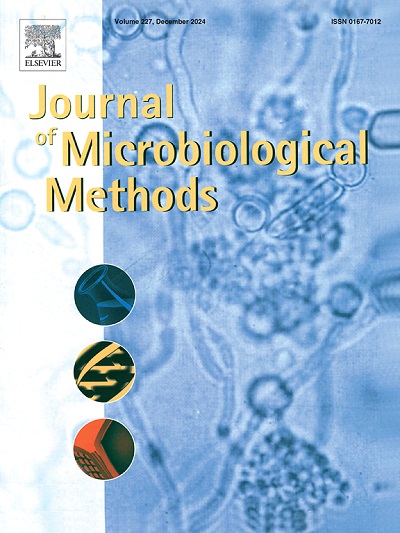用流式细胞术分析食物中营养细胞和孢子萌发
IF 1.7
4区 生物学
Q4 BIOCHEMICAL RESEARCH METHODS
引用次数: 0
摘要
检测食物中形成孢子的细菌是至关重要的,因为它们可能会导致腐败。然而,传统的微生物检测既耗时又低效。在这里,我们报告使用流式细胞术与5-氰基-2,3-二醇- 2h -四氯唑(CTC)染色来快速检测和监测孢子的萌发。我们特别研究了Paenibacillus, Sporosarcina和Clostridium spp.的产孢和代谢活性,并使用真实的食品样品验证了我们的方法。我们的方法能够快速检测食物中形成孢子的细菌和孢子的萌发。流式细胞术是区分食物样品中营养细胞和孢子的一种有价值的工具。在这项研究中,我们使用CTC染色的流式细胞术来测定孢子萌发和营养细胞数量。我们的研究结果显示,0.2%过氧乙酸处理抑制了孢子的萌发,通过流式细胞术检测到代谢活性孢子计数减少,营养细胞计数增加。此外,流式细胞术能够快速准确地从营养细胞中分化孢子,在几分钟内就能定量了解细菌的生存能力。这些发现表明,流式细胞术是一种可靠和实用的实时食品安全微生物监测工具,具有传统的基于培养的方法所无法比拟的优势。本文章由计算机程序翻译,如有差异,请以英文原文为准。
Analysis of vegetative cells and spore germination in food using flow cytometry
The detection of spore-forming bacteria in food is crucial because they potentially cause spoilage. However, traditional microbial tests are time-consuming and inefficient. Here, we report the use of flow cytometry with 5-cyano-2,3-ditolyl-2H-tetrazolium chloride (CTC) staining for the rapid detection and monitoring of spore germination. In particular, we investigated sporulation and metabolic activity in Paenibacillus, Sporosarcina, and Clostridium spp. and validated our method using real food samples. Our approach enabled the rapid detection of spore-forming bacteria and spore germination followed by outgrowth in food. Flow cytometry is a valuable tool for distinguishing vegetative cells and spores in food samples. In this study, we used flow cytometry with CTC staining to determine spore germination and vegetative cell populations. Our findings revealed that 0.2 % peracetic acid treatment inhibited spore germination, as indicated by decreased metabolically active spore count and increased vegetative cell count detected via flow cytometry. Additionally, flow cytometry enabled rapid and accurate differentiation of spores from vegetative cells, providing quantitative insights into bacterial viability within minutes. These findings indicate that flow cytometry is a reliable and practical tool for real-time microbial monitoring in food safety, offering advantages over conventional culture-based methods.
求助全文
通过发布文献求助,成功后即可免费获取论文全文。
去求助
来源期刊

Journal of microbiological methods
生物-生化研究方法
CiteScore
4.30
自引率
4.50%
发文量
151
审稿时长
29 days
期刊介绍:
The Journal of Microbiological Methods publishes scholarly and original articles, notes and review articles. These articles must include novel and/or state-of-the-art methods, or significant improvements to existing methods. Novel and innovative applications of current methods that are validated and useful will also be published. JMM strives for scholarship, innovation and excellence. This demands scientific rigour, the best available methods and technologies, correctly replicated experiments/tests, the inclusion of proper controls, calibrations, and the correct statistical analysis. The presentation of the data must support the interpretation of the method/approach.
All aspects of microbiology are covered, except virology. These include agricultural microbiology, applied and environmental microbiology, bioassays, bioinformatics, biotechnology, biochemical microbiology, clinical microbiology, diagnostics, food monitoring and quality control microbiology, microbial genetics and genomics, geomicrobiology, microbiome methods regardless of habitat, high through-put sequencing methods and analysis, microbial pathogenesis and host responses, metabolomics, metagenomics, metaproteomics, microbial ecology and diversity, microbial physiology, microbial ultra-structure, microscopic and imaging methods, molecular microbiology, mycology, novel mathematical microbiology and modelling, parasitology, plant-microbe interactions, protein markers/profiles, proteomics, pyrosequencing, public health microbiology, radioisotopes applied to microbiology, robotics applied to microbiological methods,rumen microbiology, microbiological methods for space missions and extreme environments, sampling methods and samplers, soil and sediment microbiology, transcriptomics, veterinary microbiology, sero-diagnostics and typing/identification.
 求助内容:
求助内容: 应助结果提醒方式:
应助结果提醒方式:


